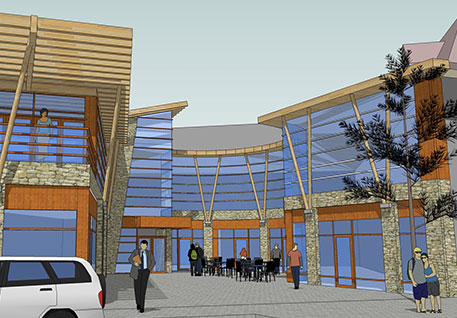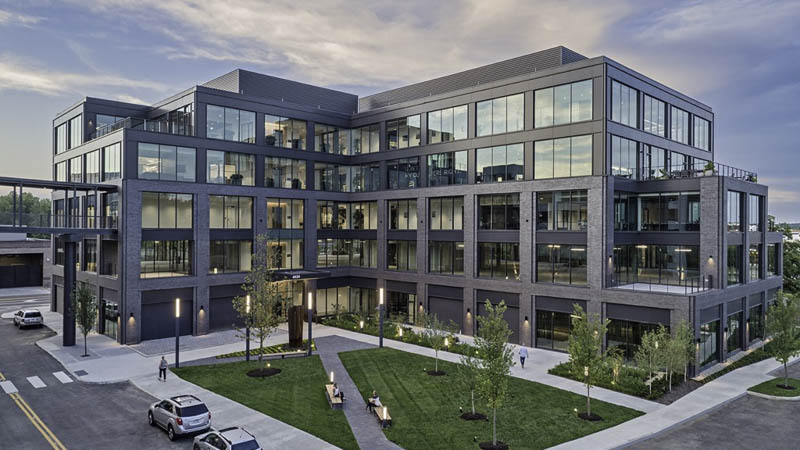Revealing the Comprehensive Solutions Offered by Commercial Architects for Modern Advancement
Commercial Architects serve an important feature in modern growth jobs. They mix style appearances with capability while adhering to governing demands. Their experience expands past plain building and construction, incorporating sustainable practices and ingenious technologies. As they browse intricate zoning legislations, Architects team up with various stakeholders to bring visions to life. This multifaceted technique raises questions about the progressing function of Architects fit contemporary areas and the influence of their service future advancements.
Recognizing the Function of Commercial Architects in Modern Developments
In modern urban landscapes, Commercial Architects play a crucial role fit functional and visual rooms that satisfy varied company needs. Their competence extends beyond simple layout; they browse complicated zoning legislations, building codes, and ecological guidelines. By collaborating with customers, they identify particular needs, guaranteeing that each job aligns with the customer's vision while additionally thinking about useful facets such as sustainability and cost-effectiveness. Commercial Architects are proficient at incorporating cutting-edge modern technologies and products right into their layouts, enhancing both the performance and energy efficiency of structures. They conduct comprehensive site analyses to evaluate the possible challenges and opportunities offered by an area. Additionally, efficient communication with professionals and other stakeholders is crucial, making certain that the job proceeds smoothly from conception to conclusion. Inevitably, Commercial Architects contribute in developing rooms that not only meet functional functions yet additionally add to the overall character and vibrancy of metropolitan atmospheres.
Idea Design: Transforming Concepts Into Fact
Idea layout acts as a vital phase in Commercial design, where ingenious design remedies emerge from innovative thinking. This procedure counts on collective ideation, bringing together diverse perspectives to fine-tune and boost first concepts. As concepts materialize, they change from abstract concepts right into concrete building realities.
Innovative Layout Solutions
Transforming ideas right into truth is the trademark of innovative style remedies in Commercial style. These services mix imagination with capability, resolving the special needs of contemporary developments. By leveraging sophisticated innovations and sustainable practices, Architects craft areas that are not only visually enticing however also efficient and adaptable. Emphasis on customer experience drives the layout procedure, making certain that environments foster efficiency and cooperation. Each job take advantage of a tailored technique, where ideas are carefully created to reflect the customer's vision while taking into consideration future fads. Ingenious design remedies additionally prioritize flexibility, permitting modifications in time as service demands evolve. Inevitably, these methods enhance the general value of Commercial areas, making them pivotal in today's competitive landscape.

Joint Ideation Refine
Cooperation works as the foundation of the ideation procedure in Commercial design, cultivating creative thinking and innovation amongst varied stakeholders. Architects, customers, engineers, and community participants involve in dynamic discussions, making sure that all viewpoints are considered. This inclusive strategy enables for the expedition of different style ideas, encouraging special services that align with the project's vision. Via workshops and conceptualizing sessions, concepts develop and refine, changing preliminary concepts into tangible styles. Innovation additionally plays a crucial role, with tools such as Structure Details Modeling (BIM) helping with real-time collaboration and changes. Eventually, this joint ideation process not only improves the style result however also cultivates a sense of ownership and investment amongst all celebrations included, bring about effective Commercial developments.
Zoning Evaluation: Navigating Regulations and Conformity
As designers begin on brand-new tasks, recognizing zoning laws is vital to making sure compliance and staying clear of pricey delays. Zoning evaluation plays a vital role in this process, as it involves assessing local zoning legislations that dictate land usage, building elevation, density, and troubles. Commercial Architects possess the know-how to browse these complicated laws, helping customers identify acceptable uses and any kind of needed differences.
Sustainable Layout Practices: Structure for the Future
Sustainable design methods are significantly essential in the domain of Commercial style, particularly as environmental issues continue to intensify. Architects focus on environmentally friendly materials, energy-efficient systems, and design strategies that reduce waste and ecological impact. Integrating sustainable power sources, such as solar panels and wind generators, permits buildings to generate their own power and lower reliance on fossil fuels.Furthermore, lasting style emphasizes the significance of indoor ecological top quality. This includes making use of natural light, improving air flow, and choosing safe products to boost occupant wellness and efficiency. Green roofing systems and living walls are also popular attributes that add to biodiversity and city cooling.Additionally, Commercial Architects frequently integrate water conservation techniques, like rain harvesting and drought-resistant landscaping. Through these ingenious strategies, they create rooms that not just meet contemporary demands but additionally promote a lasting future, resolving the growing need for accountable development in the modern world.
Project Management: Ensuring Timely and Effective Execution
Effective project monitoring is essential for making certain that Commercial style projects are completed on schedule and within budget plan. This role incorporates a variety of duties, consisting of the coordination of various stakeholders, timelines, and resources. Commercial Architects utilize their competence to create detailed job plans that lay out important milestones and deliverables, enabling systematic progress tracking.Regular interaction amongst employee and clients is important, cultivating transparency and helping with timely decision-making. Risk monitoring approaches are likewise used to identify potential difficulties early, making it possible for positive remedies to be developed. By using check that sophisticated task monitoring tools, Architects can keep track of project performance in real-time, making modifications as needed to maintain performance.
Interior Decoration: Creating Functional and Visual Rooms
Inside design plays an essential function in boosting both functionality and aesthetics within Commercial rooms. Effective space planning can optimize process and boost user experience, while aesthetic style concepts contribute to a visually appealing environment - commercial architects. Together, these aspects produce rooms that are not just useful yet likewise inspiring
Area Planning Performance
While optimizing the energy of offered area, Commercial Architects prioritize room preparation efficiency to create both useful and visually pleasing environments. This strategy entails cautious analysis of the spatial format to ensure optimal use every square foot. Architects think about variables such as workflow, ease of access, and all-natural light to improve functionality. By tactically positioning furniture, equipment, and workstations, they promote motion and interaction amongst customers, advertising productivity. Additionally, zoning different locations for certain functions aids in managing noise and personal privacy, developing a harmonious environment. Via reliable room preparation, Commercial Architects can transform constraints right into chances, making certain that each area meets the varied demands of its occupants while sticking to governing needs and industry requirements.
Visual Style Concepts
Aesthetic design concepts play a necessary role fit settings that are not only practical yet also aesthetically appealing. These concepts lead Commercial Architects in producing spaces that resonate with users while boosting brand identity. Crucial element consist of equilibrium, proportion, Click Here and consistency, which interact to produce a natural look. Color plans and products are carefully chosen to stimulate wanted emotions and support the general motif. Furthermore, lighting plays a critical function, affecting state of mind and exposure while highlighting building features. By integrating these concepts, Architects assure that rooms are not only functional however additionally inviting and inspiring. Ultimately, effective aesthetic design promotes a positive individual experience, urging interaction and satisfaction in Commercial environments.
Partnership With Stakeholders: Fostering Successful Collaborations
Effective partnerships in Commercial design depend upon efficient partnership with stakeholders, making certain that every voice is listened to and valued. This joint strategy involves engaging different celebrations, including clients, specialists, and community participants, throughout the layout and advancement procedure. By fostering open communication, Commercial Architects can deal with issues, gather understandings, and straighten the project's vision with stakeholder expectations.The combination of diverse perspectives improves creativity and advancement, resulting in even more practical and visually pleasing designs. Normal conferences, feedback sessions, and workshops facilitate this discussion, permitting Architects to adapt their plans in response to stakeholder input. On top of that, establishing count on via openness and responsibility strengthens these collaborations, leading to a smoother project execution.Ultimately, the success of modern-day growths depends on the Architects' ability to browse and balance differing passions, developing a collaborative setting that promotes common objectives and shared success.
Regularly Asked Concerns
How Do Commercial Architects Take Care Of Budget Plan Constraints During a Task?

What Kinds of Software Application Do Commercial Architects Frequently Utilize?
Commercial Architects typically use software application such more info here as AutoCAD for composing, Revit for Building Information Modeling, SketchUp for 3D modeling, and project administration tools like Microsoft Task to improve collaboration and streamline process throughout the design process.
Can Commercial Architects Aid With Obtaining Financing for Projects?
Commercial Architects can aid in acquiring financing for projects by preparing in-depth proposals, aiding to express design visions, and giving economic projections that can boost the possibility of safeguarding needed funding from financiers or financial organizations.
How Do Architects Make Certain Security During the Construction Refine?
Architects ensure security during building and construction by implementing extensive layout requirements, coordinating with engineers, performing routine site examinations, sticking to local policies, and cultivating interaction among all stakeholders to alleviate risks and advertise a safe and secure workplace.
What Ongoing Support Do Architects Provide After Task Completion?
After task completion, Architects use ongoing assistance via maintenance consultations, performance evaluations, and style modifications. They assure structures satisfy developing requirements, address possible issues, and maintain conformity with guidelines, promoting a lasting relationship with clients.